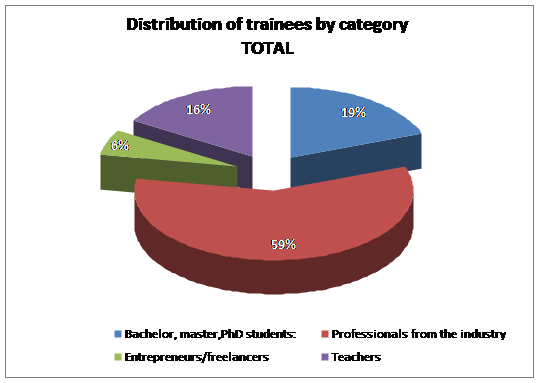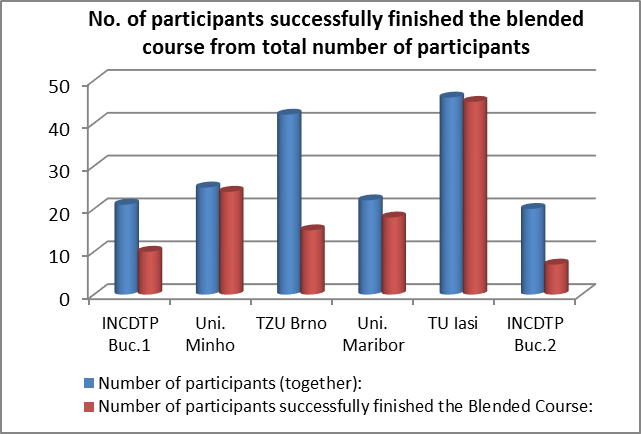Guide for courses evaluation and upgrading
Although the project main actors, tutors and learners, have reached the envisaged work targets, and the global experience within this group has been positively evaluated, there is always a need of analysing and improving, if necessary. In this context, the Guide for courses evaluation and upgrading, synthesize the relevant aspects and conclusions drawn after each partner evaluation.
4. Analysis of the information provided by the partner institutions
4.3. About the participants within the target groups
Each partner of the project consortium was responsible for training a group of minimum 20 participants. This indicator has been met by all project partners.
Graphical representations from Figure 2 to Figure 11 were made based on the numerical data provided by the partner institutions in the project.
Table 2 summarize information about the participants in blended courses organised by the five partners of the consortium.
Table 2. Information about the participants in Blended course
|
Information about the Blended course |
Partners of the consortium |
TOTAL |
|||||
|
INCDTP Buc.1 |
Uni. Minho |
TZU Brno |
Uni. Maribor |
TU Iasi |
INCDTP Buc.2 |
||
|
Number of participants (together): |
21 |
25 |
42 |
22 |
46 |
20 |
176 |
|
Number of employed participants: |
20 |
19 |
40 |
10 |
37 |
20 |
146 |
|
Number of participants outside the organizing University: |
21 |
25 |
0 |
8 |
33 |
20 |
107 |
|
Number of modules taught: |
6 |
7 |
7 |
7 |
7 |
6 |
- |
|
Number of participants successfully finished the Blended Course: |
10 |
24 |
15 |
18 |
45 |
7 |
112 |
- One can note that a significant number of participants are employees (Figure 2).
- Except two partners from the project consortium, TZU and TU Maribor, a significant percentage of the trainees in the target groups are coming from outside the training institution (Figure 3).
- The success rate regarding completing the online courses on the e-learning platform ranges between 97% (TUIASI) to 35% (TZU& INCDTP Buc.2) (Figure 4).
|
|
|
|
Figure 2. |
Figure 3 |
|
Figure 4. |
|
- Participants included in the target groups came from the following professional categories:
- Bachelor, master, PhD students
- Professionals from the industry
- Entrepreneurs/ freelancers
- Teachers
Distribution of these categories in the training groups organized by each of the five partners in the project is presented in table 3 and graphically represented in Figure 5.
Table 3. Distribution of the trainees by professional category
|
Partners of the consortium |
TOTAL |
||||||
|
Categories of trainees |
INCDTP Buc.1 |
Uni. Minho |
TZU Brno |
Uni. Maribor |
TU Iasi |
INCDTP Buc.2 |
|
|
Bachelor, master, PhD students: |
1 |
3 |
4 |
13 |
13 |
0 |
34 |
|
Professionals from the industry |
19 |
19 |
34 |
3 |
8 |
20 |
103 |
|
Entrepreneurs/ freelancers |
1 |
3 |
3 |
1 |
2 |
0 |
10 |
|
Teachers |
0 |
0 |
1 |
5 |
23 |
0 |
29 |
|
TOTAL |
21 |
25 |
42 |
22 |
46 |
20 |
176 |

|
Figure 5. |
In Figures 6, 7, 8, 9 and 10 is shown the detailed distribution of the four professional categories in the target groups of each project partner. From these graphs one can note the following aspects:
- In the target groups organised by the INCDTP Bucharest, Uni. Minho and TZU Brno, the professionals from the industry represent the main category of the participants (over 75%).
- At Univ. Maribor, the majority were students (59%) and at TUIASI the most numerous category is represented by high school Teachers (50%).


Figure 6 Figure 7.

Figure 8


Figure 9 Figure 10
For the entire consortium, a number of 176 persons were trained, distributed by professional category as follows (Figure 11):
- Bachelor, master, PhD students: 19%
- Professionals from the industry: 59%
- Entrepreneurs / freelancers: 6%
- Teachers: 16%

Figure 11

 .
.